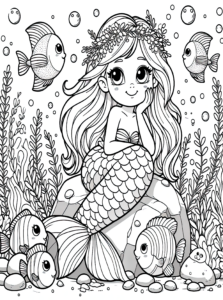Discover the Benefits of a Coloring Book for Children
Coloring books for youngsters have been a well-known pastime for quite some time, yet they give much more than just an approach to occupy kids. These creative outlets provide numerous benefits that contribute to the overall development of young minds. In this blog post, we will delve into the various advantages associated with coloring activities and how they play an essential role in fostering your child’s growth.
We’ll explore how coloring books help develop fine motor skills, boost confidence through creative expression, and enhance cognitive resilience in children. Additionally, we’ll discuss tips on choosing the right coloring book based on age-appropriate themes and designs while focusing on educational content.
Furthermore, we’ll examine the role of coloring sheets in early education by highlighting their importance in developing proper grip strength and improving handwriting skills. We will also address common myths surrounding coloring books for children and discuss emotional benefits derived from engaging in art activities.
Table of Contents
- Benefits of Coloring Books for Children
- Developing Fine Motor Skills Through Coloring Activities
- Boosting Confidence with Creative Expression
- Enhancing Cognitive Resilience in Children
- Choosing the Right Coloring Book
- The Role of Coloring Sheets in Early Education
- Debunking Myths Surrounding Coloring Books
- Emotional Benefits of Engaging in Art Activities
- FAQs in Relation to Coloring Book for Children
- Conclusion
Benefits of Coloring Books for Children
Coloring books offer many advantages for a child’s growth, such as stimulating creativity, improving hand-eye coordination, and increasing self-esteem. They also help develop color-recognition skills and introduce new knowledge through pictures while enhancing problem-solving abilities. This article will discuss the many benefits of coloring books in a child’s growth.
Developing Fine Motor Skills Through Coloring Activities
Fine motor skills are essential for young children as they learn to perform everyday tasks like writing or buttoning clothes. Coloring activities require kids to use their fingers and hands in precise ways that strengthen these muscles over time. As they practice holding colored pencils or crayons correctly, their grip strength improves, allowing them better control when engaging in other fine motor tasks.
Boosting Confidence with Creative Expression
Creative expression is vital for a child’s emotional well-being and sense of identity. Art therapy studies have shown that artistic activities can improve mood by providing an outlet for emotions that may be difficult to express verbally. When children complete a coloring page successfully, it boosts their confidence and encourages them to explore more complex designs or create original artwork independently.
Enhancing Cognitive Resilience in Children
- Cognitive Development: The process of selecting colors helps younger kids build cognitive resilience by learning about different color combinations and practicing decision-making skills.
- Problem Solving: Coloring pages often include intricate designs that require children to think critically about how they will approach the task. This practice helps develop their problem-solving abilities and encourages persistence.
- Color Recognition: As kids learn to identify various colors, they improve their visual perception skills, an essential aspect of cognitive development. Moreover, coloring apps can further enhance color recognition by offering a wide range of shades for experimentation.
Incorporating coloring books into your child’s daily routine can significantly contribute to their overall growth and learning experience. By engaging in these activities regularly, young children are better equipped with the necessary tools for success both inside and outside the classroom environment.
Choosing the Right Coloring Book
When choosing a coloring book for your child, consider their age, interests, and complexity of the designs to ensure they remain engaged while being sufficiently challenged. This ensures that they remain engaged in the activity while still being challenged enough to foster learning and development.
Age-appropriate themes and designs
The first step in choosing an ideal coloring book is identifying age-appropriate themes and designs. For younger kids, opt for simple illustrations with large shapes and minimal details. As children grow older, they can handle more intricate drawings that require increased focus and precision. Some popular options include:
- Dinosaurs
- Superheroes
- Ocean animals
- Educational content (e.g., alphabet or numbers)
Balancing complexity with simplicity
Finding a balance between complexity and simplicity is crucial when selecting a coloring book. Too many intricate details may overwhelm young children who are still developing their fine motor skills; however, overly simplistic images may not hold the attention of older kids. Seek out coloring books that provide a blend of uncomplicated and intricate drawings, permitting your kid to advance at their own speed.
Focusing on educational content
Coloring books can be both fun and educational when they incorporate elements that teach children about various subjects. For example, alphabet-themed coloring pages help reinforce letter recognition while teaching new vocabulary words. Similarly, animal-themed coloring books can introduce young learners to different species and habitats. By choosing a book with an educational focus, you’ll provide your child with engaging activities that foster creativity and learning.
Think about the age-appropriateness of topics, a combination of complexity and ease, as well as educationally enriching content when picking out a coloring book for your kid to make sure it meets their requirements. Remember to consider age-appropriate themes, balance complexity with simplicity, and prioritize educational content in order to promote cognitive development through this enjoyable pastime.
Key Takeaway:
When choosing a coloring book for kids, it’s important to consider their age and preferences. Look for age-appropriate themes and designs that balance complexity with simplicity, while also incorporating educational content to promote cognitive development. This will ensure your child remains engaged in the activity while still being challenged enough to foster learning and creativity.
The Role of Coloring Sheets in Early Education
Coloring sheets are valuable tools that prepare preschoolers for school by helping them hold writing instruments correctly. These worksheets aid in developing hand-eye coordination while teaching focus on boundaries, which ultimately improves handwriting and academic performance. In this section, we will discuss the importance of proper grip strength, handwriting improvement through coloring exercises, and learning patience during artistic creation.
Importance of Proper Grip Strength
Developing a child’s grip strength is crucial to their ability to write legibly and efficiently as they grow older. Coloring activities help children build up these muscles by encouraging them to grasp colored pencils, crayons, or markers with precision and control. This not only benefits their fine motor skills but also sets the foundation for future success in schoolwork requiring manual dexterity.
Handwriting Improvement Through Coloring Exercises
Coloring exercises can significantly impact a child’s handwriting abilities by promoting hand-eye coordination, attention to detail, and spatial awareness. As young children practice staying within the lines on coloring pages, they learn how much pressure needs to be applied when holding a writing instrument – an essential skill for producing clear letters later on in life.
- Focused Practice: Children need focused practice sessions where they concentrate solely on improving their penmanship through repetitive motions like tracing shapes or connecting dots before moving onto more complex tasks such as letter formation.
- Variety: Offering different types of coloring sheets featuring various themes, patterns, and designs keeps kids engaged while also exposing them to new challenges that help improve their handwriting skills.
Learning Patience During Artistic Creation
Coloring activities teach children the importance of patience and perseverance as they work on completing a picture. This is especially true for more intricate coloring pages, which require time and effort to finish. As younger kids learn how to manage their frustration when faced with challenging tasks, they develop essential coping mechanisms that will serve them well in both academic settings and everyday life situations.
Incorporating coloring sheets into your child’s early education routine can provide numerous benefits for their cognitive development, fine motor skills, and emotional wellbeing. By choosing age-appropriate materials that challenge yet engage young minds, parents can foster a love for learning while setting the stage for future success in school.
Key Takeaway:
Coloring sheets are important tools in preparing preschoolers for school, as they aid in developing hand-eye coordination and focus on boundaries. They also help to improve grip strength, handwriting skills, and teach patience during artistic creation. Incorporating age-appropriate coloring activities into a child’s early education routine can provide numerous benefits for their cognitive development, fine motor skills, and emotional wellbeing.
Debunking Myths Surrounding Coloring Books
There are several myths about how coloring books contribute to a child’s education process; however, these misconceptions do not diminish their value when used appropriately alongside other educational resources or techniques. In this section, we will address some common myths and provide clarification on the true benefits of using coloring books for children.
Myth #1 – Fine eye-hand coordination only applies at younger ages
Some people believe that fine eye-hand coordination is only relevant for young children who are just learning to grasp objects and draw. However, this skill continues to develop throughout childhood and even into adulthood. Engaging in activities such as coloring can help strengthen these skills by requiring precise hand movements while focusing on intricate details within the coloring pages. As a result, older kids and adults can also benefit from using coloring books.
Addressing concerns over perfectionism
A common concern among parents is that encouraging their children to color within the lines may lead to unhealthy levels of perfectionism. While it is essential to strike a balance between allowing creative freedom and promoting discipline in completing tasks accurately, there is no evidence suggesting that using coloring sheets fosters excessive perfectionism in children. On the contrary, practicing staying within boundaries helps improve focus and attention span which ultimately contributes positively towards a child’s development.
In addition to debunking these myths surrounding coloring books’ impact on cognitive development, it’s crucial for parents to recognize that they are just one tool in a vast array of educational resources. To ensure well-rounded development, children should be exposed to various activities that foster creativity and learning, such as art therapy, reading books, solving puzzles, and engaging with age-appropriate technology like coloring apps.
Ultimately, the key is to find a balance between using coloring books as an enjoyable pastime while still incorporating other essential elements for your child’s cognitive growth. By doing this, you can offer them a variety of ways to acquire new skills and hone their capabilities in multiple areas.
Emotional Benefits of Engaging in Art Activities
The act of engaging with art materials can be therapeutic for kids experiencing stress or anxiety. It supports overall mental health by providing an outlet for emotional expression without relying solely on verbal communication, making it an excellent tool for caregivers seeking insight into a child’s emotional state.
Art Therapy: A Creative Outlet for Emotional Expression
Art therapy is a well-recognized therapeutic practice that motivates kids to show their sentiments through imaginative activities, such as coloring, painting and sketching. By participating in these activities, children can process complex feelings and develop coping mechanisms to handle challenging situations better. Coloring books are one way parents can introduce the benefits of art therapy at home.
Promoting Mindfulness Through Coloring Books
Mindfulness is the practice of focusing on the present moment while acknowledging thoughts and feelings without judgment. Mindful practices have been shown to improve mental health, especially when combined with artistic endeavors like coloring pages. As children concentrate on filling in intricate designs with various color combinations, they become more aware of their inner thoughts and emotions, a valuable skill that promotes self-awareness and emotional regulation.
Bonding Over Shared Creativity
- Social connection: When parents join their kids during coloring sessions, it fosters stronger bonds between them while also creating opportunities for open conversations about emotions.
- Easing tension: Sharing creative experiences helps both adults and young children unwind after a long day by redirecting focus away from daily stressors towards relaxing and enjoyable activities.
- Building empathy: As children learn to express their emotions through art, they also develop a deeper understanding of the feelings and perspectives of others, ultimately nurturing empathy and compassion.
Reducing Anxiety with Coloring Apps
Digital coloring apps are becoming a popular substitute or addition to traditional coloring books, offering convenience, accessibility and eco-friendliness. Coloring apps provide convenience, accessibility and even environmental friendliness. Furthermore, many coloring apps for kids are designed with built-in relaxation features like calming music or guided meditation exercises that can help reduce anxiety levels while engaging in creative pursuits.
Including coloring books in a child’s routine can not only help with cognitive growth, but also provide emotional support during difficult times. By encouraging artistic expression and mindfulness practices at a young age, parents can lay the foundation for resilient mental health throughout their child’s life.
Key Takeaway:
Engaging in art activities can be therapeutic for kids experiencing stress or anxiety, providing an outlet for emotional expression. Art therapy encourages children to express their emotions through creative activities like coloring and promotes mindfulness, self-awareness, and emotional regulation. Coloring books foster cognitive development and provide essential emotional support during times of stress while also fostering social connection, easing tension, building empathy and reducing anxiety levels.
FAQs in Relation to Coloring Book for Children
What skills does coloring work on for kids?
Coloring helps children develop various skills, including fine motor skills, hand-eye coordination, focus and concentration, color recognition, spatial awareness, creativity, and self-expression. It also contributes to cognitive development by enhancing problem-solving abilities and critical thinking.
What is the benefit of a coloring book?
A coloring book provides numerous benefits such as promoting relaxation, reducing stress levels in children and adults alike. Additionally, it encourages creativity through artistic expression while improving attention span and concentration. Coloring books can also serve as an educational tool by incorporating learning themes like numbers or letters.
How does coloring help a child’s social development?
Coloring aids in social development by encouraging cooperation among peers during group activities or sharing materials like crayons or colored pencils. It fosters communication skills when discussing their artwork with others while developing empathy towards different perspectives through appreciation of diverse art styles.
What is the importance of a coloring book for kids?
The importance of a coloring book lies in its ability to stimulate creativity and imagination while providing opportunities for skill-building exercises that promote early childhood education goals such as language acquisition or math concepts understanding. Furthermore, it offers emotional benefits by serving as an outlet for self-expression which boosts confidence levels over time.
Conclusion
In conclusion, coloring books for children provide numerous benefits such as color recognition skill development, encouraging creativity and boosting self-esteem through art. It is important to choose age-appropriate content with subject matter preferences and level of detail considerations. Preparing preschoolers for school with coloring sheets helps in developing correct writing tool grip, enhancing hand-eye coordination and focusing on boundaries.
Critical thinking development can be achieved through handwriting improvement from an early age, increased focus during tasks and building lifelong cognitive skills. Debunking myths about children’s coloring books includes the limited benefits related to eye-hand coordination and that they cause stress or perfectionism. Coloring also plays a vital role in emotional development by processing emotions through coloring, building self-esteem with creative expression and developing patience during artistic tasks.
Overall, Lifetime Coloring Books offers a wide range of high-quality coloring books for children that enhance fine motor skills by improving pencil grip strength, boosting hand dexterity and skillful manipulation of small objects. Visit lifetimecoloringbooks.com today to browse our selection!








